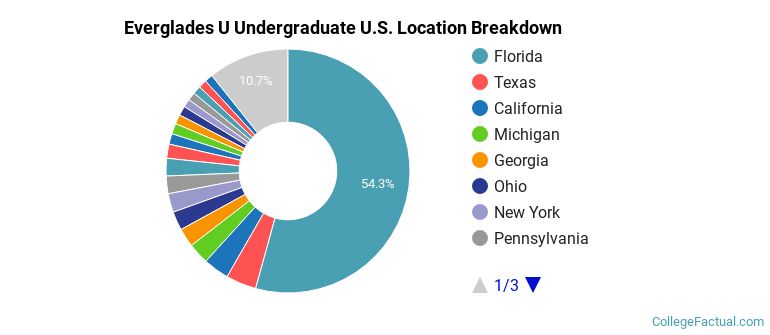 by our College Data Analytics Team
by our College Data Analytics TeamEverglades U total enrollment is approximately 2,247 students. 1,877 are undergraduates and 143 are graduate students.
Male/Female Breakdown of Undergraduates
The full-time Everglades U undergraduate population is made up of 45% women, and 55% men.

For the gender breakdown for all students, go here.
Everglades U Racial/Ethnic Breakdown of Undergraduates

| Race/Ethnicity | Number |
|---|---|
| White | 854 |
| Hispanic | 395 |
| Black or African American | 350 |
| Unknown | 188 |
| Multi-Ethnic | 37 |
| Asian | 24 |
| Native Hawaiian or Pacific Islander | 4 |
| International | 0 |
See racial/ethnic breakdown for all students.
Male/Female Breakdown of Graduate Students
About 48% of full-time grad students are women, and 52% men.

For the gender breakdown for all students, go here.
Everglades U Racial-Ethnic Breakdown of Graduate Students

| Race/Ethnicity | Number |
|---|---|
| White | 54 |
| Black or African American | 37 |
| Hispanic | 32 |
| Unknown | 7 |
| Multi-Ethnic | 5 |
| Asian | 3 |
| Native Hawaiian or Pacific Islander | 1 |
| International | 1 |
See racial/ethnic breakdown for all students.

| Race/Ethnicity | Number |
|---|---|
| White | 999 |
| Hispanic | 475 |
| Black or African American | 447 |
| Unknown | 214 |
| Multi-Ethnic | 44 |
| Asian | 33 |
| Native Hawaiian or Pacific Islander | 5 |
| International | 1 |

There are approximately 1,035 female students and 1,212 male students at Everglades U.
Everglades U ranks 193 out of 2,183 when it comes to geographic diversity.
46.8% of Everglades U students come from out of state, and 0% come from out of the country.

The undergraduate student body is split among 45 states (may include Washington D.C.). Click on the map for more detail.

| State | Amount |
|---|---|
| Florida | 349 |
| Texas | 26 |
| California | 22 |
| Michigan | 18 |
| Georgia | 16 |
A traditional college student is defined as being between the ages of 18-21. At Everglades U, 4.46% of students fall into that category, compared to the national average of 60%.

| Student Age Group | Amount |
|---|---|
| 35 and over | 1,143 |
| 30-34 | 472 |
| 25-29 | 467 |
| 22-24 | 223 |
| 20-21 | 85 |
| 18-19 | 24 |
| Under 18 | 0 |
Footnotes
*The racial-ethnic minorities count is calculated by taking the total number of students and subtracting white students, international students, and students whose race/ethnicity was unknown. This number is then divided by the total number of students at the school to obtain the racial-ethnic minorities percentage.
References
Department of Homeland Security Citizenship and Immigration Services
Image Credit: By Comayagua99 under License